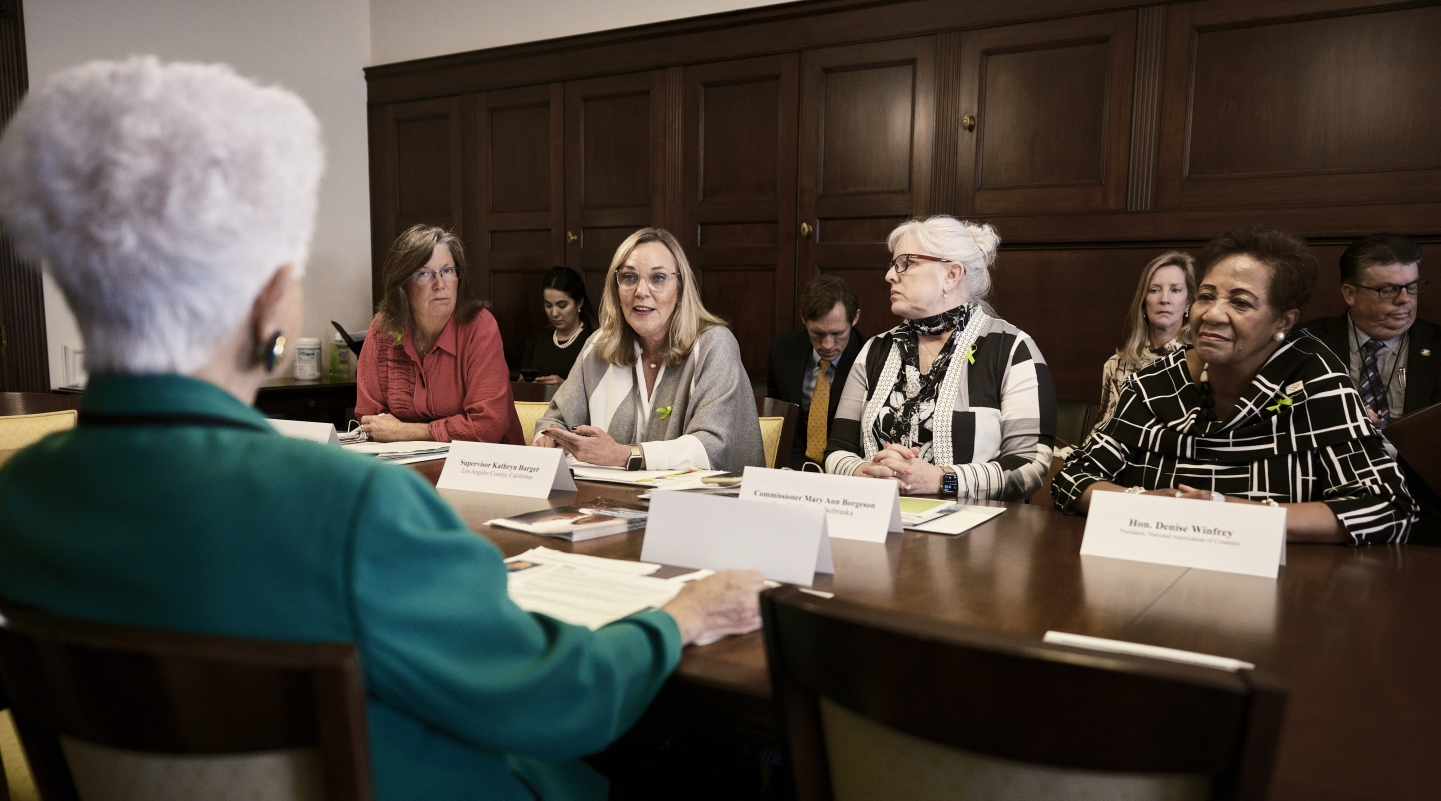2024 Federal Policy Priorities

Upcoming Events
Related News
America’s 3,069 county governments provide essential building blocks for healthy, safe and vibrant communities.
Introduction
America’s 3,069 county governments provide essential building blocks for healthy, safe and vibrant communities.
Counties invest over $600 billion each year through the leadership of 38,000 county elected officials and almost 3.6 million county employees. Counties support and maintain key public and community infrastructure, help nurture and sustain a skilled workforce to support dynamic local economies, and promote public health and safety to protect our citizens.
NACo supports federal policies and programs that equip county governments with the resources and flexibility needed to serve our residents effectively. NACo works to preserve local decision-making and protect counties from unfunded mandates and preemption of local authority. Since counties implement many federal programs at the local level and must enforce many federal regulations, NACo encourages meaningful intergovernmental consultation with counties throughout all federal policy, program and regulatory development processes.
NACo policy positions are introduced, debated, and voted on by ten policy steering committees with over 1,400 county officials, as well as the NACo Board of Directors and NACo’s full membership.
- Counties own and operate 45 percent of America’s roads and 38 percent of bridges.
- Seventy-eight percent of public transit agencies are supported by counties
- Counties invest $134 billion in infrastructure and maintaining and operating public works
- Sixty-two percent of counties have federal public land
- Counties support and operate nearly 1,000 hospitals, over 800 long-term care facilities, 750 behavioral health centers and 1,900 public health departments
- County governments operate 2,875 of our nation’s 3,160 local jails
Counties as Intergovernmental Partners
Amplify the unique county role in the intergovernmental system and federal policymaking
County governments are instrumental partners in our nation’s intergovernmental system, which balances, divides and shares power and responsibilities between all levels of government. Uniquely positioned to implement and administer policies and investments at the local level, NACo supports meaningful and consistent engagement between intergovernmental partners, and efforts that recognize and respect the unique roles and responsibilities of counties. Counties support the passage of the Restore the Partnership Act and the Unfunded Mandates Information and Transparency Act. These bills will reduce the regulatory burden of unfunded federal mandates on the public, increase transparency, foster intergovernmental dialogue and unite all levels of government in supporting our system of federalism.
Similar to the above legislation that recognizes counties as intergovernmental partners, NACo applauds the provisions of the American Rescue Plan Act (ARPA), Bipartisan Infrastructure Law (BIL), Inflation Reduction Act (IRA) and the CHIPS and Science Act that designated funds directly to county governments and will continue to advocate for further legislation that unites all levels of government in supporting our unparalleled system of federalism.
By the Numbers
$600B
Invested Each Year
Counties invest over $600 billion each year in taxpayer resources.
40K
Elected Officials
Counties make these investments through the leadership of nearly 40,000 county elected officials
3.6M
County employees
3.6 million county employees implement and manage these investments.
Direct Investment in Counties
Support bipartisan direct federal investment in counties
NACo supports legislation that recognizes counties as essential intergovernmental partners through long-term, direct investments in local governments. As owners and operators of a vast amount of the nation’s infrastructure, effective implementation of the Bipartisan Infrastructure Law (BIL) will require meaningful and ongoing engagement between officials at all levels of government. Competitive programs that counties are eligible to apply for in the BIL directly must also be fully funded at their authorized levels to ensure successful implementation.
Environmental stewardship is another primary function of county governments to create healthy, safe and vibrant communities for our residents. Counties support the opportunity to pursue clean energy initiatives and reduce emissions through new competitive grant programs, and a direct pay option in lieu of clean energy tax credits in the Inflation Reduction Act (IRA).
Furthermore, counties seek to revitalize their economies and foster innovation through the implementation of the RECOMPETE Pilot and Regional Tech Hubs programs in the CHIPS and Science Act.
By the Numbers
$134B
Invested in Physical Infrastructure and Public Works
Counties invest $134 billion annually in building, maintaining and operating physical infrastructure and public works, including transportation, water systems, ports, dams, hospitals, schools, libraries and courthouses
45%
Of Public Road Miles
Counties own and operate 45 percent of all public roads
38%
Of Bridges
Counties own almost 38 percent of the National Bridge Inventory
34%
Of Airports
Counties are directly involved in 34 percent of airports
40%
Of All Public Transportation Systems
Counties are directly involved in 40 percent of all public transportation systems
x
x
x
Elections and Election Workers
Maintain election integrity and strengthen election worker safety
In the United States, the nation’s 3,069 counties traditionally administer and fund elections at the local level, including overseeing polling places and coordinating poll workers for federal, state and local elections. County election officials work diligently with federal, state and other local election officials to ensure the safety and security of our voting systems. County election officials administer elections in a way that is accurate, safe, secure and accessible for all voters.
Counties oppose legislation that imposes impractical requirements on the election process that adversely affect the conduct of state and local elections. Counties support legislation requiring federal entities to work with local governments to increase cybersecurity in elections and allocate funding directly to counties.
In recent years, the widespread circulation of misinformation and disinformation surrounding the administration of elections has led to a series of new challenges election officials must address, including the increase of targeted threats and harassment toward election officials. NACo urges Congress to enact legislation that will impose appropriate penalties for offenses related to harassing or intimidating election officials in the performance of their duty.
NACo urges Congress to enact legislation that will impose appropriate penalties for offenses related to harassing or intimidating election officials in the performance of their duty and has endorsed the Election Worker Protection Act (S.1318) led by Sen. Amy Klobuchar (D-Minn.).
By the Numbers
201M
People Registered To Vote in 2022
More than 201 million people were registered to vote in the 2022 midterm election within jurisdictions where counties play a major role in administering and coordinating elections.
94M
Voter Registration Forms
Between the 2018 and 2020 general elections, county jurisdictions processed over 94 million voter registration forms
100K
County-Administered Polling Places
Counties administer elections through the funding and management of over 100,000 polling places staffed with over 630,000 poll workers each election cycle.
Mental and Behavioral Health
Pursue better outcomes within and across behavioral health, homelessness and criminal justice systems
Counties invest billions each year in systems aimed at improving the health outcomes of residents. Behavioral health programs like the Community Mental Health Services Block Grant and the Substance Use Prevention, Treatment, and Recovery Block Grant exemplify the federal-state and county partnerships that help us keep our communities healthy. Counties use these grants to provide a range of services for adults and children with serious mental illnesses, including employment and housing assistance, case management (including Assertive Community Treatment), school-based support services, family and parenting education and peer support. Congress must fully fund these programs so that counties can continue to leverage these critical tools for mitigating the ongoing mental health crisis.
The federal-state and local partnership by which Medicaid is run serves as a vital tool for enhancing county systems of care and improving healthcare access. Maintaining and strengthening this partnership through federal laws and regulations that acknowledge counties’ dual role as administrators and investors in Medicaid enhances the program’s integrity and its capacity to serve our nation’s most vulnerable citizens. County public health initiatives are bolstered by dedicated, direct, and flexible funding. This is why counties advocate for the safeguarding of the Prevention and Public Health Fund, the only federal funding source intended for local public health.
Counties are committed to enhancing health outcomes for justice-involved individuals and endorse policies that eliminate obstacles to care during crucial transition phases. To advance these efforts, Congress must pass federal policies that amend the Medicaid Inmate Exclusion policy and ensure uninterrupted access to federal health benefits for pretrial adults and the immediate reinstatement of health care benefits for adults reentering their community. Programs such as the Justice and Mental Health Collaboration Program (JMHCP) aid counties in mitigating mental illness in jails by promoting inter-system cooperation for screening and treatment- work that can be further supported by fully financing this program at its authorized level for the fiscal year 2024.
By the Numbers
$80B
Invested in Community Health Systems
Counties invest more than $80 billion annually in community health systems that serve approximately 75 percent of the U.S. population.
750
Behavioral Health Authorities
Through 750 behavioral health authorities and community providers, county governments plan and operate community-based services for persons with mental illness and substance use conditions.
44%
Of Jail Inmates with Mental Illness
Approximately 44 percent of jail inmates have a mental illness and 63 percent of jail inmates have a substance use disorder.
Farm Bill
Pass a bipartisan farm bill with the inclusion of county priorities
The Farm Bill authorizes key programs that help counties make critical investments in infrastructure, economic development, workforce training, nutrition and conservation within some of our nation’s most underserved communities. Preserving and expanding these programs is vital to the continued prosperity of both urban and rural counties and the residents we serve. With the current legislation set to expire on September 30, 2024, counties will continue to work with our federal partners to ensure that a five-year, bipartisan Farm Bill that includes key county priorities is signed into law in 2024.
Counties support full funding for all twelve titles of the Farm Bill. For the 70 percent of America’s counties, parishes and boroughs considered rural, the Farm Bill represents a significant opportunity to address acute issues unique to rural America. Programs authorized through the bill help counties strengthen rural infrastructure, deliver essential public services to county residents, protect our nation’s food supply, increase access to healthy food for low-income populations through the Supplemental Nutrition Assistance Program (SNAP), and empower locally-led environmental stewardship and conservation initiatives.
NACo also supports two additional legislative proposals intended for inclusion in the 2024 Farm Bill. The Treating Tribes and Counties as Good Neighbors Act (S. 697/H.R. 1450) would extend eligibility to counties under the Good Neighbor Authority Program, which would allow them to reinvest receipts gained from authorized restoration projects. The Good Neighbor Authority currently only allows the U.S. Department of Agriculture’s (USDA) Forest Service to work with state forestry agencies. The Rural Partnership and Prosperity Act (S. 3309) would create a competitive grant program to provide multiyear, flexible funding for rural development initiatives, as well as create a grant program to fund technical assistance providers in rural areas and expands the Rural Partners Network, which puts federal staff on the ground in rural communities.
PILT and SRS
Support counties with federal public lands by fully funding Payments In Lieu of Taxes (PILT) and the Secure Rural Schools (SRS) program
Counties support maintaining long-term full funding for the Payments in Lieu of Taxes (PILT) program, which compensates public lands counties for untaxable federal land. Without predictable mandatory funding, PILT will remain a discretionary program subject to the annual appropriations process. Public lands counties rely on PILT to provide critical services like infrastructure maintenance, clean water delivery and law enforcement to residents and visitors alike. Counties urge the administration and members of Congress to support long-term, predictable full funding for PILT in FY 2024 and beyond, and modifying the program to make PILT payments to counties with smaller populations more equitable. Counties also support extending the Secure Rural Schools (SRS) program as a transitional funding mechanism until the federal government fully implements a sustainable, long-term forest management program with adequate revenue sharing for forest counties and schools. NACo supports legislation such as the Secure Rural Schools Reauthorization Act of 2023 that provides forest revenue-sharing payments to counties and promotes active natural resource management.
NACo will continue to urge leadership in both chambers and on both sides of the aisle to work together to enact a long-term, sustainable solution to ensure stable revenue sources to national forest counties. Furthermore, counties support legislation and policies which would ensure federal land management agencies aggressively reduce the excess wildfire fuels on the entire National Forest System. The annual average number of acres burned has grown dramatically from 3.3 million acres per year in the 1990s to 7 million annually since the year 2000. Counties support legislation for financing the suppression of catastrophic wildland fires without borrowing from other agency accounts for active management for forest and rangeland health and post-fire restoration and mitigation. Counties oppose any attempt to shift the costs of wildland fire suppression from federal agencies to counties.
By the Numbers
62%
Of Counties Have Federal Land
Sixty-two percent of counties have federal land within their boundaries, and unlike other local property owners, the federal government does not pay traditional property taxes.
1,900
Counties with PILT Payments
PILT payments are necessary to support essential local government services in over 1,900 counties.
Local Decision for Land Use and Environmental Planning
Promote county priorities and local decision-making in federal rulemaking around land use, environmental quality, and energy development
Counties support federal policies that balance environmental, public health and safety and local economic needs. As both regulators and regulated entities, counties are responsible for protecting local air, water and land resources through delegated authority under state and federal laws. For example, counties spend $23 billion on sewerage and solid waste management per year. Federal regulations and guidelines are more effective if they are clear, understandable and can be easily administered at the local level.
As the U.S. Environmental Protection Agency (EPA) and other federal agencies move forward with future rulemaking, NACo supports further federal investments and consistent and meaningful engagement with local government officials. Counties additionally support increased federal funding to support the successful implementation of future rulemakings. Counties urge the EPA to continue to hold meaningful consultation with local governments early in the rulemaking process to reduce the risk of unfunded mandates and other unintended consequences caused by implementing federal policy.
Disaster Preparedness Response and Recovery
Strengthen community resilience through enhanced federal, state and county partnerships for disaster preparedness, response and recovery
Counties engage in all aspects of emergency management, including planning, preparation, mitigation, response, and recovery. As the frequency and costs of disasters increase, counties urge Congress and the administration to provide increased federal resources to counties so they can continue to protect our residents, property, infrastructure systems, and local economies.
Counties support reforms to FEMA’s Public Assistance Program to ensure expedited reimbursement for communities following a disaster.
Counties call on Congress to pass long-term reauthorization and reform legislation for the National Flood Insurance Program (NFIP) to improve affordability, mitigation assistance, flood risk mapping, and program administration. The program aims to reduce the impact of flooding on private and public structures by providing affordable insurance to property owners and by encouraging communities to adopt and enforce floodplain management regulations.
Furthermore, counties support increased funding for the Emergency Management Grant Program and other mitigation grants to support local hazard mitigation and preparedness.
By the Numbers
28
Separate Billion-Dollar Disasters
In 2022, the nation experienced 18 separate billion-dollar disasters which totaled approximately $165 billion in damages, and in 2023, the nation experienced an unprecedented 28 billion-dollar disasters, totaling over $100 billion dollars as of January 2024.
800
Counties Per Year
On average, over 800 counties per year experience a presidentially declared disaster
Local Flexibility to Support Economic Mobility
Enhance federal flexibilities, incentives and resources for county investments, policies and services that support at-risk, vulnerable residents, promote economic mobility and workforce readiness, and alleviate the housing affordability and access crisis.
Counties are key players in crafting long-term economic development strategies, implementing local policies that support labor market recovery, and facilitating public-private partnerships that foster innovation. We support federal programs and investments that help counties address our unique local economic challenges, reduce unemployment and create sustained economic opportunity.
Counties support increased funding for the Community Development Block Grant Program (CDBG) that assists urban, suburban and rural communities in improving housing and living conditions and expanding economic opportunities for low- and moderate-income residents. CDBG helps create jobs by expanding and retaining businesses and is an essential tool for helping local governments tackle serious challenges facing our communities.
Counties also support reauthorization legislation of the Workforce Innovation and Opportunity Act (WIOA) that preserves local governance authority, while promoting innovation and flexibility to respond to local emerging economic realities and business needs.
Counties are integral partners in providing services and supports that stabilize vulnerable households. NACo supports expanded resources and flexibilities in federal assistance programs that combat intergenerational poverty, promote safe and stable families, strengthen early childhood systems and help older adults live independently in their communities. Counties support structural changes to the Child Tax Credit to increase the number of eligible households and provide higher benefit amounts, increased funding and flexibility for child welfare programs, and increased investments in the child care system to ensure families can access affordable, high-quality care while engaging in the workforce. Counties also call for a substantive reauthorization of the Temporary Assistance for Needy Families (TANF) program that preserves key programmatic flexibility while expanding the ability of county human services agencies to support families in their journeys to well-being and self-sufficiency.
By the Numbers
62%
Of Counties with Poverty Above the National Average
Nearly 62 percent of counties have poverty rates exceeding the national average.
18%
Of Counties Have Housing Affordability Issues
In 18 percent of counties, households must spend more than 3.5 times their annual income to afford a typical home.
24%
Of Households Are Cost-Burdened
Nearly a quarter (24 percent) of households that occupy rental units are severely cost-burdened
High-Speed Internet
Deploy high-speed internet that is affordable, reliable, and accessible while preserving local decision making, partnerships and innovation.
County officials play a crucial role in pursuing sustainable broadband access, affordability and reliability.
County Supported Broadband Solutions
- attract broadband service, boost enrollment in federal broadband affordability programs, and promote broadband adoption efforts to targeted communities to bridge the digital divide.
- preserve the local authority of county governments in the deployment of broadband services
- Remove state-imposed bans and restrictions that stop counties from making investments in local broadband networks.
The Broadband Equity Access and Deployment (BEAD) program, administered by the National Telecommunications and Information Administration (NTIA), offers a historic opportunity to connect all unserved and underserved residents to high-speed internet. The BEAD program’s success depends on robust local coordination, and counties are uniquely positioned to contribute to their state’s challenge process and planning process to ensure that BEAD funds are successful in significantly reducing barriers to broadband access.
By the Numbers
23M
Households Enrolled in ACP
With help from counties, over 23 million households are now enrolled in the Affordable Connectivity Program (ACP) since its inception in January 2021, which is approximately 30 percent of eligible households. Counties are now advocating to continue Congressional funding for the ACP to ensure the program does not lapse.
< 40%
Have Access to High-Speed Internet
Less than 40 percent of locations in the country have access to fiber-based high-speed internet, measured at 100/20 Mbps, with the problem exacerbated in rural and hard-to-build regions. Counties are prioritizing the deployment of future-proof broadband technology to ensure residents can benefit from long-term access to high-quality broadband services.
Counties across the country have begun adoption of model digital equity policy frameworks to ensure all of their residents can benefit from access to high-speed internet.
Government Affairs

Mark Ritacco

Blaire Bryant

Jessica Jennings

Rachel Mackey

Michael Matthews

Brett Mattson

Seamus Dowdall

Sarah Gimont

Owen Hart

Paige Mellerio

Julia Cortina

Maxx Silvan


